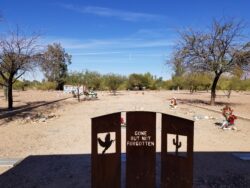January, 2025 Monthly Reflection
AEHT on the Ground: Reflections from the Tucson-Nogales Border Visit
Sister Sally Duffy, SC
 “If today you hear God’s voice, harden not your hearts” Hebrews 3:7
“If today you hear God’s voice, harden not your hearts” Hebrews 3:7
To deepen our understanding of forced migration and human trafficking, the Alliance to End Human Trafficking (Alliance)’s Board of Directors met in November in Tucson, Arizona, for board meeting and board education. Alliance and the National Advocacy Center provided a backgrounder on the “Nexus between Forced Migration and Human Trafficking” as part of our advocacy efforts in 2023 and 2024.
This backgrounder highlighted some of this nexus. They included, “Traffickers thrive where vulnerability is high, where people are desperate, and their options are limited or nonexistent. People on the move and recent immigrants are at particular risk of exploitation by traffickers because of their precarious social and economic circumstances. The International Organization for Migration estimates the number of international migrants to be at least 281 million people. They are refugees, asylum seekers, labor migrants, and those displaced by conflict or natural disasters. They are fleeing floods, famine, war, violence, endemic poverty, organized crime, political corruption, and the effects of climate change. They are both desperate and resilient.
Immigration and human trafficking are clearly interconnected, especially in the United States. Polaris estimates that 77 percent of persons trafficked in the United States each year are immigrants (Polaris Analysis of 2021 Data from the National Human Trafficking Hotline, pg. 8 of 29). Migrants and immigrants, including children, are sold for sex and labor and exploited across a range of industries in the United States.
Unfortunately, the root causes of human trafficking, including the significant and unique vulnerabilities faced by those forced to migrate, have been largely overlooked. In the past, U.S. anti-trafficking policy has taken a primarily criminal justice approach. While interdiction and prosecution of traffickers is essential, it alone is insufficient. If there is any hope of putting an end to this horrendous crime anti-trafficking, work must focus on its root causes. Today, that means mitigating the risks to populations most at risk for sex and labor trafficking – immigrants, especially women and children, who are forced to leave their homes.”
After an all-day board meeting in Tucson, we traveled to Nogales, Senora, Mexico, and the KINO Border Institute. There, we helped serve breakfast to migrants. Then, we took a walking tour of Nogales. We learned how guns are being trafficked from the United States into Mexico and Central and South America.
In mid-May of 2024, three Congresspeople, including Joaquin Castro (TX-20), introduced the Stop Arming Cartels Act. This legislation builds on the “Bipartisan Safer Communities Act” to address the sale and trafficking of firearms from the United States to transnational criminal organizations around the world. This Bill prohibits the further sale of 0.50 caliber rifles, regulates existing 0.50 caliber rifles, applies the same reporting requirements for handguns to rifles, and establishes new avenues for the victims of gun violence to seek justice from manufacturers and dealers who violate U.S. laws.
“When I speak to leaders in Latin America and the Caribbean, their number-one request is for Congress to stop American weapons of war from falling into the hands of the gangs that are destabilizing their countries,” said Congressman Castro. “Especially in Mexico, access to .50 caliber rifles has fundamentally altered the balance of power between criminal organizations and the government and allowed cartels to become virtually untouchable. Congress can have meaningful debates about broader gun safety reform — but we should all be able to agree that U.S. gun manufacturers should not be selling the weapons that Mexican cartels use to down military helicopters and attack police convoys. The Stop Arming Cartels Act is an important step to restore regional stability and prevent the violence that drives forced migration across our hemisphere.”
As we walked in Nogales, right next to the border wall, it was calm and no one was sleeping in the streets. Pharmacies, dentists, and physicians occupied much of the commercial space, serving many Americans, especially “snowbirds” who spend their winters in Arizona.
When the United States deports migrants to Mexico or any country, not releasing deportees in the dark or without any means of contacting family or friends can minimize trafficking by cartels and gangs. This is also forced migration back to their home country that threatens death, violence, trafficking, etc.
A Border Patrol agent was acquitted of involuntary manslaughter in the deadly shooting of a Mexican teen, court records show. “Lonnie Swartz was accused of shooting through a border fence in Nogales, Arizona, in 2012 and killing 16-year-old José Antonio Elena Rodríguez, who was on the Mexican side of the border. The agent fired 14 to 30 shots, and 10 of those bullets hit the teen, officials said. Swartz said he shot through the fence because he was getting attacked by rock throwers and feared for his life”, the Arizona Republic reported. The teen’s family criticized the verdict and said they will keep fighting for justice. We prayed for Jose’s family and friends as we observed the steep incline that would have protected someone from serious harm by rock-throwing below on the Mexican street. We asked for forgiveness for our complicity in systems that oppress rather than liberate.
Migrants do not need sympathy but rather need understanding and empathy, which leads to solidarity. Forced to migrate to protect their family, especially their children, migrants are carrying children, food, and diapers as they make this dangerous journey. We spent time in the afternoon playing with the children at KINO before walking back to the United States of America.
On the last day, we visited the Federal District Courtroom in Tucson in the morning to witness around 35 or more individuals ordered by the judge to be deported to Mexico. In the afternoon, we visited the Pima County Fiduciary, where unidentified remains of migrants are buried, and we visited Evergreen Mortuary & Cemetery. We prayed for migrants forced to migrate and many who died in the desert. Thankfully, the Coroner persists in trying to identify the migrants so the Coroner can notify their families.
God, we pray to hear Your voice and see Jesus’s face in all our brothers and sisters. Amen

Sister Sally Duffy, SC
Board Chair
Alliance to End Human Trafficking
Category: Monthly Reflections

